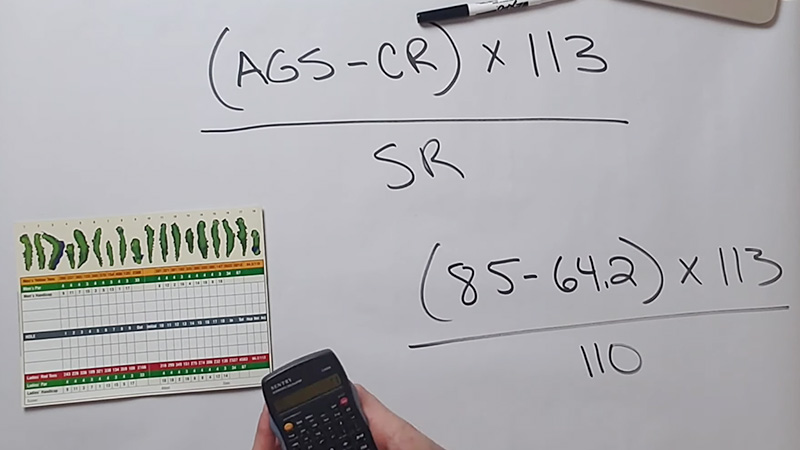A Golf Handicap Index stands as a pivotal metric in the world of golf, embodying equity and camaraderie on the green. As a numerical representation of a player’s potential skill, it empowers golfers of varying abilities to engage in spirited competition.
This index transcends individual performance, embracing the diversity of golf courses’ challenges. It’s a universal language, fostering fair play and inclusivity among players globally.
Through a meticulous calculation process, golfers’ recent scores and course difficulties converge to create this index, allowing enthusiasts to confidently face off regardless of their proficiency levels.
The Golf Handicap Index embodies the sport’s essence: the pursuit of excellence and unity through diversity.

What Is a Golf Handicap Index?
A Golf Handicap Index is a standardized measure of a golfer’s playing ability, designed to provide a fair and equitable way for players of differing skill levels to compete against each other.
It’s a numerical representation that reflects a golfer’s potential performance on any given day and allows players of varying skill levels to play together on a relatively even playing field.
The concept of a handicap system in golf is rooted in the sport’s fundamental principle of fair competition.
Since golf is played on various courses with varying levels of difficulty, it can be challenging for players of different skill levels to compete directly against each other without some form of adjustment. This is where the handicap system comes into play.
The Golf Handicap Index is calculated based on a player’s recent performance in rounds of golf. It takes into account a player’s scores and adjusts them for the relative difficulty of the courses they’ve played on.
The primary goal of the handicap system is to enable players to compete on a level playing field, regardless of their individual skill levels, by factoring in the course’s difficulty.
Key points to understand about the Golf Handicap Index:
Calculation Basis
The Handicap Index is calculated based on a golfer’s recent golf scores. These scores are used to calculate the player’s potential ability rather than their average performance.
Differing Course Difficulty
Golf courses vary in difficulty due to factors like length, hazards, and layout. A player’s Handicap Index takes into account these variations, allowing for fair competition on any course.
Equitable Competition
The primary purpose of the Handicap Index is to enable fair competition among players of varying skill levels.
When playing in events or tournaments, a player’s Handicap Index is used to calculate a “Course Handicap,” which indicates the number of strokes the player should receive or give to compete evenly with scratch golfers.
Calculating the Handicap Index
The calculation process involves several steps that take into account a player’s recent golf scores, the difficulty of the courses played, and a “handicap differential” formula. The system typically uses a golfer’s best scores from their most recent rounds.
Updating the Index
A player’s Handicap Index is updated regularly, usually every two weeks. This ensures that the Index remains reflective of the player’s current skill level.
Limiting Scores
To prevent exceptional scores from heavily influencing a golfer’s Handicap Index, there are limits to how much a player’s score can affect their index in a single round.
Use in Competitions
Many golf events and tournaments use the Handicap Index to level the playing field. The Course Handicap, which is derived from the Handicap Index and the specific course’s difficulty, determines the number of strokes a player either gives or receives in the competition.
Global Standardization
The concept of a Handicap Index is widely accepted and used internationally, allowing golfers from different countries to compete fairly against each other.
Monitoring Progress
Golfers can track their Handicap Index through golf associations or clubs that are affiliated with a handicap system. This allows players to see how their playing ability evolves over time.
Advantages Of A Golf Handicap Index

The Golf Handicap Index system offers several advantages that enhance the game of golf and make it more enjoyable for players of all skill levels.
Here are some key advantages:
Fair Competition
One of the primary benefits of the Handicap Index system is that it promotes fair competition among golfers of varying abilities.
It allows players with different skill levels to compete on an equal footing, creating a more level playing field and ensuring that the outcome of a match or tournament is determined by skill rather than sheer ability.
Inclusivity
The Handicap Index system encourages inclusivity by enabling golfers of all levels to participate in events and enjoy the game together. Novice and recreational players can comfortably join competitive rounds without feeling overwhelmed by more experienced golfers.
Encourages Improvement
Having a Handicap Index motivates golfers to improve their skills. As they see their index decrease over time, it’s a tangible indication of their progress and serves as an incentive to continue practicing and refining their game.
Flexible Course Selection
Golfers can play on various courses with different levels of difficulty while still maintaining a fair competition. The Handicap Index adjusts to the specific course, ensuring that the golfer’s performance is evaluated relative to the course’s challenges.
Consistency in Tournament Play
In tournaments, players are often required to play with golfers they may not have played with before. The Handicap Index provides a consistent measure to determine equitable scoring adjustments, making it easier to manage tournaments and matchups.
Social Enjoyment
The Handicap Index system facilitates social interaction among golfers. Friends or family members with different skill levels can comfortably play together without feeling like the game is heavily skewed in favor of one player.
Global Standardization
The Handicap Index system is recognized and used internationally, allowing golfers from different parts of the world to compete seamlessly. This standardization contributes to the global appeal of golf as a sport.
Balanced Team Play
In team events, where players of varying abilities are often grouped together, the Handicap Index ensures that teams are balanced. Each player’s index contributes to the overall team handicap, creating a more competitive and engaging experience.
Record of Progress
The Handicap Index serves as a record of a golfer’s progress over time. This record can be rewarding to look back on, showing how a player’s skills have evolved and how they have overcome challenges.
How Can You Calculate a Golf Handicap Index?

To calculate your golf handicap index, you need to enter your scores through the GHIN mobile app or another authorized service.
You can establish a handicap index with as few as three 18-hole scores, but once you have entered 20 scores, your handicap index is derived by taking the average of your 8 best score differentials.
A score differential is your score minus the course rating, multiplied by 113 and divided by the slope rating. The course rating and slope rating are numbers that indicate the difficulty of the course and tees you played.
The course rating is the expected score for a scratch golfer (a golfer with a zero handicap index), and the slope rating is a number between 55 and 155 that measures how much harder the course is for a bogey golfer (a golfer with a handicap index of about 20) than for a scratch golfer. The higher the slope rating, the more difficult the course.
For example, let’s say you played an 18-hole round on a course with a course rating of 72.0 and a slope rating of 120, and you scored 90. Your score differential would be:
(90 – 72) x 113 / 120 = 17.1
This means that on that day, on that course, you played 17.1 strokes worse than a scratch golfer. If you have 20 scores in your record, you would take your 8 lowest score differentials, add them up, and divide by 8 to get your handicap index.
Difference Between a Golf Handicap Index and a Course Handicap
A Golf Handicap Index and a Course Handicap are both important concepts within the realm of golf handicapping, but they serve different purposes and are used in different contexts.
Here’s a breakdown of the key differences between the two:
Golf Handicap Index
Definition
The Golf Handicap Index is a standardized measure of a golfer’s potential playing ability. It represents the number of strokes a player should be able to play above or below the course rating on a neutral course.
It is a general measure of a golfer’s skill level and allows golfers of varying abilities to compete on an equitable basis.
Calculation Basis
The Handicap Index is calculated based on a formula that takes into account a golfer’s recent scores, the difficulty of the courses played, and the concept of a “handicap differential.” It is designed to represent a player’s potential, rather than their average performance.
Frequency of Update
The Handicap Index is typically updated on a regular schedule, often every two weeks. This ensures that the index remains reflective of the player’s current skill level based on their most recent rounds.
Use in Tournaments
The Handicap Index is used as a reference point to calculate a player’s Course Handicap for a specific course. This allows players of different skill levels to compete fairly in tournaments or matches, regardless of the course’s difficulty.
Course Handicap
Definition
The Course Handicap is a specific measure that adjusts a golfer’s Handicap Index based on the difficulty of the golf course they are playing.
It represents the number of strokes a player should receive or give on a particular course to have a fair competition against scratch golfers (those with a Handicap Index of 0).
Calculation Basis
The Course Handicap is calculated using a formula that incorporates the Handicap Index and the course’s slope rating. The slope rating takes into account the relative difficulty of the course for players of different skill levels.
Specific to the Course
Unlike the Handicap Index, which is a general measure of a golfer’s ability, the Course Handicap is specific to the course being played. It adjusts the player’s potential ability to match the challenges of the particular course.
Use in Play
The Course Handicap is used during play to determine the number of strokes a player should receive or give on each hole based on the course’s rating and slope. It ensures that players of different abilities can compete on an equal footing within the context of a specific course.
FAQS
What’s a Golf Handicap Index?
A measure of a golfer’s potential skill, ensuring fair competition by adjusting scores based on course difficulty.
How’s it calculated?
Calculated from recent scores, course ratings, and slope ratings, with the lowest differentials averaged and adjusted.
Why is it important?
Encourages fairness, inclusivity, and improvement by enabling players of different abilities to compete equally.
How often is it updated?
Usually updated every two weeks to reflect a golfer’s current ability based on recent scores.
Does it change with courses?
Yes, it’s adjusted for course difficulty through the Course Handicap, ensuring equitable play.
To Recap
In the intricate tapestry of golf, the Handicap Index emerges as an emblem of equity and unity. It goes beyond mere numbers, embodying the very essence of the sport’s spirit. By harmonizing the diverse skills of players, it transforms competitions into arenas of camaraderie.
Through meticulous calculations, it bridges the gap between novices and experts, leveling the field and offering a fair chance to all.
In a world where every swing is a unique challenge, the Handicap Index stands as a beacon of inclusivity, fostering connections that defy skill disparities.
It encapsulates golf’s fundamental values: sportsmanship, growth, and the joy of shared moments on the green.

Leave a Reply